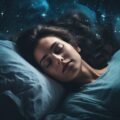Experiencing a sudden, involuntary muscle spasm just as you are about to drift off to sleep can be startling. These unexpected twitches are known as hypnic jerks, and they are more common than you might think. In this article, we will delve into the nature of hypnic jerks, their causes, and ways to reduce their occurrence.
What Are Hypnic Jerks?
Hypnic jerks, also known as sleep starts or myoclonic jerks, are brief, involuntary muscle contractions that occur as one is falling asleep. They are often described as a feeling of falling or a sudden jolt that can sometimes wake a person up. These jerks are usually harmless and occur in up to 70% of people at some point in their lives.
Causes of Hypnic Jerks
Several factors can contribute to the occurrence of hypnic jerks:
- Stress and Anxiety: High levels of stress and anxiety can lead to increased muscle tension and make hypnic jerks more likely.
- Caffeine and Stimulants: Consuming caffeine or other stimulants close to bedtime can disrupt sleep patterns and increase the likelihood of experiencing hypnic jerks.
- Physical Activity: Engaging in intense physical activity, especially later in the day, can cause muscle fatigue and contribute to hypnic jerks.
- Sleep Deprivation: Lack of adequate sleep can lead to irregular sleep patterns and increase the occurrence of hypnic jerks.
- Sleep Disorders: Conditions such as restless leg syndrome or sleep apnea can be associated with hypnic jerks.
How to Reduce Hypnic Jerks
While hypnic jerks are generally harmless, they can be disruptive. Here are some tips to minimize their frequency:
- Maintain a Regular Sleep Schedule: Going to bed and waking up at the same time every day can help regulate your sleep patterns.
- Reduce Caffeine Intake: Avoid consuming caffeine or other stimulants in the hours leading up to bedtime.
- Manage Stress: Practice relaxation techniques such as meditation, deep breathing exercises, or yoga to reduce stress and anxiety.
- Create a Relaxing Bedtime Routine: Establish a calming pre-sleep routine, such as reading a book or taking a warm bath.
- Limit Physical Activity Before Bed: Avoid vigorous exercise in the hours before bedtime to prevent muscle fatigue.
When to See a Doctor
In most cases, hypnic jerks are harmless and do not require medical attention. However, if you experience frequent or severe hypnic jerks that disrupt your sleep or are accompanied by other symptoms, it may be a good idea to consult a healthcare professional. They can help rule out any underlying sleep disorders or medical conditions that may be contributing to the issue.
Conclusion
Hypnic jerks are a common and typically harmless phenomenon that many people experience as they fall asleep. Understanding the factors that contribute to these sudden muscle spasms can help you take steps to minimize their occurrence and improve your overall sleep quality. By maintaining good sleep hygiene and managing stress, you can reduce the frequency of hypnic jerks and enjoy a more restful night’s sleep.
FAQ
What are hypnic jerks?
Hypnic jerks, also known as sleep starts, are sudden, involuntary muscle spasms that occur as a person is falling asleep. They are often described as a feeling of falling or a sudden jolt.
Are hypnic jerks harmful?
In most cases, hypnic jerks are harmless and do not require medical attention. They are a common phenomenon and usually do not indicate any serious health issues.
What causes hypnic jerks?
Several factors can contribute to hypnic jerks, including stress, anxiety, caffeine intake, physical activity, sleep deprivation, and certain sleep disorders.
How can I reduce the occurrence of hypnic jerks?
Maintaining a regular sleep schedule, reducing caffeine intake, managing stress, creating a relaxing bedtime routine, and limiting physical activity before bed can help reduce the frequency of hypnic jerks.
When should I see a doctor about hypnic jerks?
If you experience frequent or severe hypnic jerks that disrupt your sleep or are accompanied by other symptoms, it may be a good idea to consult a healthcare professional to rule out any underlying sleep disorders or medical conditions.









